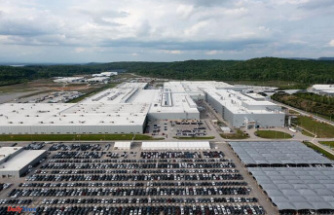In 1981 an article by the scientists Adolf Götzberger and Armin Zastrow was published in the magazine "Sonnenenergie". It was entitled "Potatoes under the collector". The authors suggested using fields in such a way that two things would be harvested there: potatoes and solar power. Because the potato gets the shade of the photovoltaic modules (PV) better than sunshine at the zenith.
The idea of "Agri-PV" was born. It then took more than 40 years for politicians to become enthusiastic about it. At the beginning of July, the Bundestag passed an amendment to the Renewable Energy Sources Act (EEG). It states that Agri-PV is now also permitted on grassland. And the Federal Ministry of Agriculture announced that the EU area premiums, which are vital for farmers, would continue to be paid for the combination of collector and potato or grassland. This means: Agri-PV is also to be regarded as agriculture from a legal point of view, not as power plant construction. Two important parameters have been changed in order to accelerate the expansion.
The Fraunhofer Institute for Solar Energy Systems (ISE) in Freiburg has been working on this topic for some time. Max Trommsdorff heads the research on Agri-PV there. In his eyes, their time has come, "faster than expected".
Trommsdorff sees Agri-PV as "a technology that has the potential to reduce water consumption and make land use much more efficient". A lot is happening in materials research: There is, for example, increased interest in organic PV films or thin-film PV, which precisely allow the light spectra required by the respective plants to pass through. "There is also a trend towards so-called bifacial PV systems, the rear of which is also electrically active," says Trommsdorff. This results in a higher electricity yield per square meter of module area.
In practice, however, it is not only good scientific arguments that decide whether it is enforced, but above all business management. Farmers now have clarity: the EU agricultural subsidy continues to exist if there is "main agricultural use", i.e. no more than 15 percent of the usual yield is lost through the solar systems. However, there are still no clear criteria for animal husbandry.
The first scientific test facility in Germany was built in 2015 in Heggelbach on Lake Constance, supervised by the ISE, among others. Six meters high, PV modules in Heggelbach shield the fields on which celery, potatoes, clover and wheat grow. A lot of light penetrates through, and the first research results were already promising.
Harvests fell as a result of the shading - around 18 percent for potatoes and wheat, but the electricity yield improves the overall balance. The land was used 60 percent more effectively than in the case of pure field farming. In the particularly hot summer of 2018, the grain harvests under PV shade were even slightly larger than on the open comparative fields. The fruits were protected.
The increasingly sunnier summers also lead to the idea of additional shading from PV roofs in other areas. In viticulture, heat and drought cause the grapes to ripen earlier, often too early. The roofing could have a particularly positive effect here, say scientists from the Geisenheim University with the famous viticultural school in the Hessian Rheingau.
Ideally, grapes should be harvested under Agri-PV roofs next year on Geisenheim's Fuchsberg. Solar roofs cover the young vines three meters high. The area is small: half a hectare. This is not about market maturity - but, as the research application says, about opening up new ways of adapting to climate change and about gaining "social participation in the design of the energy transition using a practical example". The yield effects are documented. Another question in Geisenheim is what can be achieved by integrating so-called biodiversity islands – flowering and nesting areas in the middle of the roofs.
What are the farmers saying? They have reason to think about Agri-PV: The drought is pressing, shade providers are essential for survival. The floors are dusty again in the Bavarian Rhön. How will such desert land feed us in the future?
The farmer Mathias Klöffel cultivates 180 hectares of land with his son in Großbardorf. Wheat, corn and other things ripen here. He has already done a lot to adapt farming to the new climatic conditions. Away from corn, towards crop rotations with triticale, deep-rooted alfalfa, legumes, sage. Much of it goes into the biogas plant.
Klöffel would be an ideal prospect for Agri-PV. Panels could protect his fields from drying out quickly. Klöffel, also managing director of the Agrokraft energy cooperative, thinks above all of the additional expense and calculates using his company as an example: one hectare of wheat land flushes 300 euros into his company coffers, and that's not exactly a lot. The work should be uncomplicated. "If there are five PV systems in between, the working time for mowing becomes far too long."
He doesn't think about it. His own path to solar energy was less complicated: 20 years ago, Klöffel had his barn roofs covered with PV modules. And the cooperative operates a classic solar system that eats up space.
But agri-PV technology is evolving. Large tractors and combine harvesters could drive through the rows - the height of the PV roofs is six meters, the distance between the rows of panels is 18 meters.
Markus Haastert wants to allay concerns. The entrepreneur in Berlin advises farmers with his AgroSolar Europe GmbH and reports a sharp increase in interest after the parliamentary decision in July. Questions come from all over the country: It's about the optimal shading of fruit in the Old Country, of berries in Brandenburg, of potatoes and beets in the Rhineland. But also, says Haastert, about more natural systems. "We don't want to pour concrete on the field, we want to place systems on filigree steel anchorages made like tree roots."
Many questions are still unanswered: How can panels be set up in such a way that they protect against hail in spring and improve the microclimate in summer? How to integrate irrigation systems? Will biodiversity be affected, will birds be blinded?
In agricultural science, meaningful answers are often only given for very specific applications. Every fruit, every soil, every climatic region has its own needs. It is known which fields of application are agriculturally useful: permanent grassland or grain tolerate shading in the morning and evening. The southern German energy supplier Lechwerke, for example, has been experimenting with this for a good year in the Allgäu. These panels allow grazing by sheep, goats or chickens.
Fruit crops such as pears and apples or potatoes, which need sun protection at midday, are more likely to be combined with roof-shaped PV modules standing on stilts. So far there have only been a few pilot plants in Germany – one on Lake Constance, for example, and one in Rhineland-Palatinate, where the fruit on apple orchards are successfully protected from sunburn.
How much more expensive is an elevated PV system like the one used in Heggelbach? The Competence Center for Renewable Resources in Straubing, Bavaria has data on this: 1234 euros are incurred in investment costs per kilowatt peak - the maximum output under standard conditions - electricity yield for these systems, in comparison with common ground-mounted systems it is only 572 euros. Because management is possible under the more expensive solar roof, grain or fruit sales are added, as is the EU area bonus of around 300 euros. Agri-PV will initially be profitable on very productive soils.
There are several options for so-called integrated photovoltaics such as Agri-PV, wherever solar panels are installed in existing infrastructures, on house facades, in railway tracks, on car roofs, right through to quarry ponds on which systems float. Researcher Trommsdorff and his colleagues have calculated that the potential for expanding Agri-PV is particularly large.
To do this, he compared the electricity yield of Agri-PV with other areas: They came up with 1700 gigawatts peak, which is significantly more than for the solar expansion of buildings, roads and railways, water surfaces, noise protection walls or a corresponding use of car areas. And it would be many times more than would be necessary for climate neutrality in the energy sector according to ISE calculations.
The expansion of agri-PV cannot be done with a crowbar, and there are also reservations among the population. The Freiburg ISE is also researching the acceptance of agri-PV. First results: People perceive the combination of agriculture and photovoltaics as less disturbing than pure PV areas on the ground or, above all, as wind farms.












